The Treatment Power Trio
This article by Steve Kenny was just published in Watershapes Magazine! To read the article on WaterShapes.com, click HERE
In his pursuit of delivering “gourmet water” for his clients, Steve Kenny turns to the powerful combination of ozone, UV and low levels of chlorine whenever possible. Doing so, he says, creates synergies that cannot be achieved using the technologies separately. The result is superior water quality that thrills his clients who invest in the combined treatment methods.
My approach to water treatment is embodied in a set of synergistic technologies – ozone, UV and low-levels of chlorine – that together form a powerful triumvirate of synergistic treatment systems. The big idea has been to create an approach that meets the needs of the future, to earnestly advance the state-of-the-art in water quality management.
The result has been a signature level of water quality that is mesmerizing in its beauty and pristine clarity, the paramount expression of recreational water quality.
WHY OZONE?
If you look at the original plans for many commercial aquatic facilities, it’s surprising the number of them that were designed with plumbing and electrical systems meant to accommodate ozone systems. Yet, many never had those systems installed. Likewise, when I talk to facility managers and pool operators, they may know some things about ozone but are simply not interested.
That’s all part of why, for years now, I’ve believed that ozone, the almighty O3 — one of the most powerful oxidizers known to science — has been one of our most underused and misunderstood methods of water treatment.
Ozone systems designed for treating recreational water have been around for decades. We know about the technology; in fact, most of us in the industry could probably even recite a familiar litany of benefits. Yet, the technology has always had trouble breaking through both with professionals and our clients.
The reasons vary; for some people, it’s the cost of the system and a lack of understanding of the return on investment. For others, there’s a fear factor because they don’t truly understand how ozone systems work; and, then there are those who do not appreciate the power these systems offer in our efforts to ensure superior water quality to our clients.
Truth be told, ozone systems are expensive, they can be tricky to use correctly, and earlier versions of the systems, such as those available back in the early 90s, were temperamental and prone to a handful of common problems. Today’s systems, such as those using relatively new “plasma-gap” ozone generation are far superior, but they are still expensive.
Still, I contend that once you really delve into the technology, it’s easy to see how useful it can be and how ozone might even completely change the way you think about water treatment.
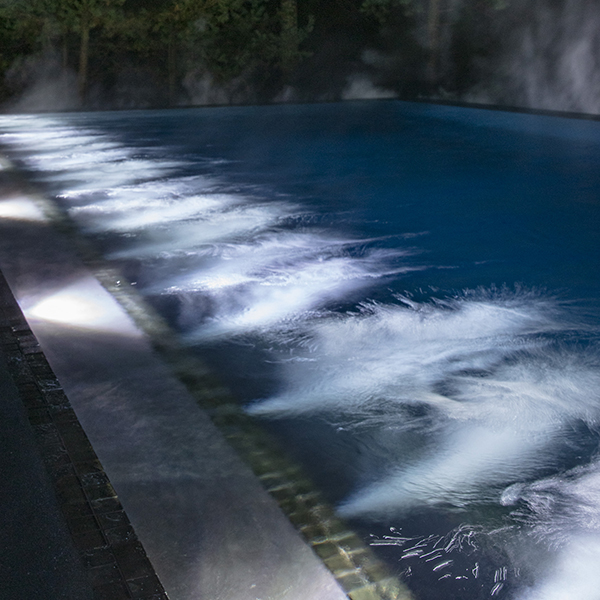
THE OZONE REVELATION
My own journey with ozone technology began about 20 years ago. I was working mostly in service at the time and was in the early stages of my understanding of water chemistry. Similar to others in the profession, I spent many frustrating days chasing changes in chemistry. It often felt like a futile attempt to stabilize pools in terms of all the issues that go along with what I now view as unstable or non-resilient water treatment. It was like constantly chasing a yo-yo.
That all changed when Del Ozone offered me a free system, given that I agreed to provide them with three months of daily chemistry readings as part of a beta testing program. I found a client who liked the idea of getting a system at a dramatically reduced price and he agreed to let me “have at it” with the daily monitoring routine.
In a very short time, I became a true believer. As I recall, it was a five-gram per hour system, which has a relatively low output by today’s standards, but, nonetheless, I was blown away by the results.
Almost from day one, with ozone, the water quality, clarity, look, and feel was nothing like I had ever seen. It was amazing just from a purely subjective view. More impressive still was what I found with the testing. Ozone effectively reduced chlorine consumption by 75 percent, which means you’re not forming disinfection by-products at nearly the rate typically associated with traditional halogen disinfection.
Ozone doesn’t impact water balance because it has no effect on pH, calcium hardness, or total alkalinity. It doesn’t add to the total dissolved solids (TDS) because, ultimately, it’s really just an unstable form of oxygen that turns into O2 after it does its work.
ELEGANT SOLUTION
Overall, ozone just seemed like a better and more elegant answer to a range of water-treatment challenges. All of those early observations have been reinforced time and time again over the years, especially as I’ve grown in my understanding of how it’s used. I’ve found that a properly functioning system — meaning you have it installed correctly and the flow rates and dosages are dialed in — will always be there to oxidize all the organic matter that enters the water via bathers or environmental conditions.
There are nuances that I’m still figuring out to this day. For example, there’s a balance between contact time and dosage. Is it better to use a lower dosage with longer contact times or vice versa? Nowadays, we set up our contact tanks so the flow rate can be adjusted (always keeping in mind we’re shooting for treating 25% of the overall flow in the ozone bypass); and, the output of many of today’s systems are self-adjusting. If, for example, the oxidation reduction potential (ORP) drops below 300 millivolts, the system will ramp up to bring the level back to the desired level of 750 or greater.
Over and over again, I’ve seen ozone installed on existing pools, and within 12 hours of turning on the system, the water takes on a distinctly improved quality. It sparkles, and there’s a shimmer and clarity that impresses most anyone who sees the improvement. It’s particularly great in indoor pools, both residential and commercial, where the pungent odor of chloramines — the infamous “chlorine smell” — is replaced by a fresh scent in the air. The entire environment just feels cleaner.
To be clear, I do not see ozone as the only solution to all water chemistry challenges because there are so many other components, for example: water balance, filtration, circulation, and sanitization.
The most important variable in the entire water treatment equation is the know-how of the professional. The reason I’m so in favor of ozone technology is precisely because I took the time to learn about it.
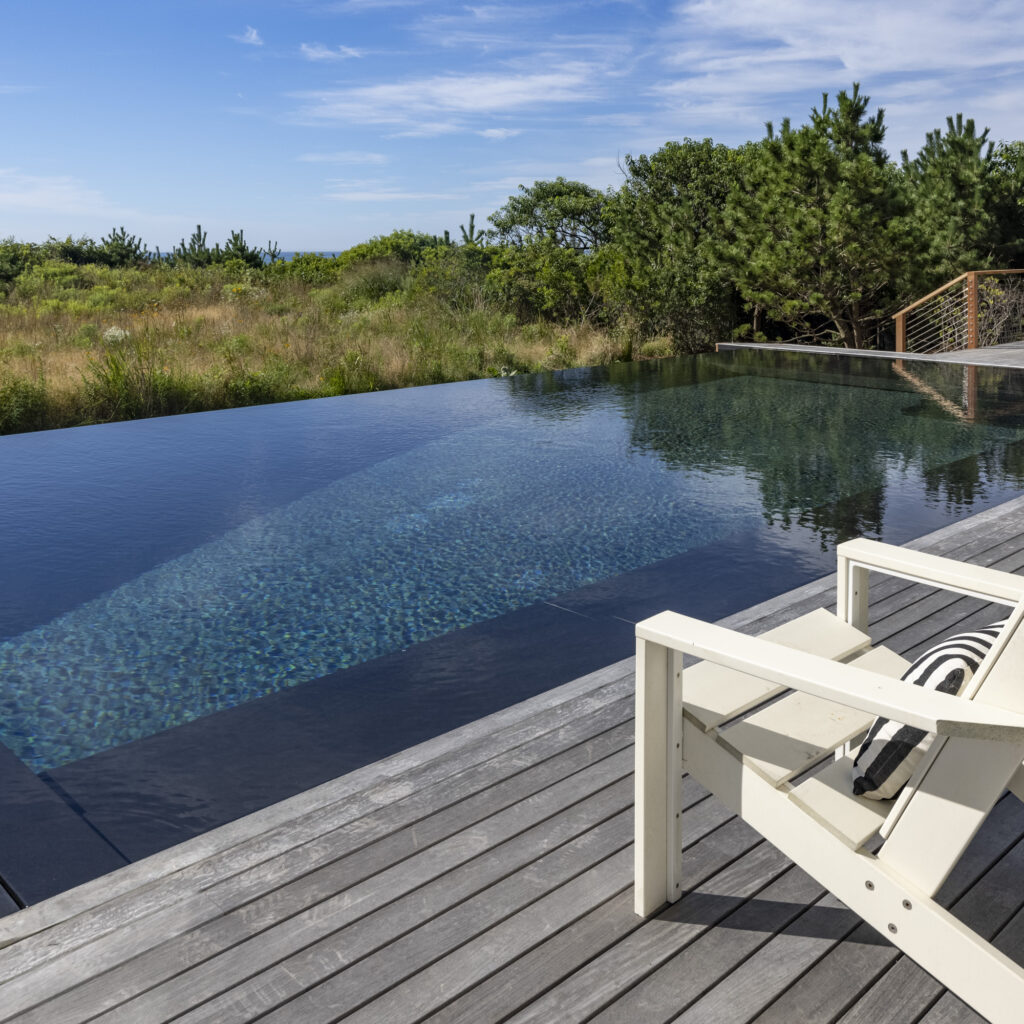
WHY UV?
Ultraviolet (UV) water treatment is both an exciting and somewhat mysterious way to sanitize water. In recent years, it’s become widely used in treating swimming pool water because it’s been proven an effective way to control pathogens without adding any chemicals to the water whatsoever.
UV offers other benefits such as destroying chloramines and controlling ozone off-gassing by turning it into hydroxyl radicals through the even more mysterious set of chemical reactions collectively known as “advanced oxidation process.”
For those reasons, UV has become a key component in our company’s approach to ensuring superior water quality for our clients. Like all the treatment methods we use, UV doesn’t offer all the answers, but it does play a role in meticulous water treatment.
PONDS AND AQUARIUMS
I first learned about UV back in 2002 when my son and I visited the Mystic Sea Aquarium in Mystic, Connecticut. I’ve always loved aquariums and have long been interested in how they keep the waters clear while harboring all those fish and other sea creatures.At one of the tanks while my son was marveling at the fish, I noticed columns of bubbles that I immediately gathered were part of the treatment scheme, not unlike the way home aquariums are oxygenated with bubblers. Off to the side I noticed a box with all these tubes feeding into it. I didn’t know what it was, but I immediately recognized the company name emblazoned on the side, “Pentair.” Given that’s a brand I associate with swimming equipment, I couldn’t help but wonder what kind of Pentair product was being used on a large-scale aquarium. Turns out, it was a UV system.
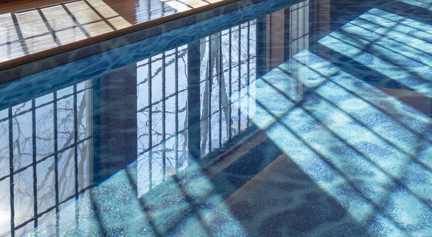
That spurred my interest, and I soon delved into discovering what UV was all about. There’s quite a lot to understanding the technology but, long story short, back in those days it was a treatment method largely associated with managing water in ponds as well as aquariums.
That all made sense because in those naturalistic systems, the idea is to treat water without using halogens, such as chlorine, because it will kill fish and plants. As it happened, back then UV was starting to also be used on swimming pools because of its ability to stunt the growth of pathogens, which proponents of the technology point out is a great way to reduce chlorine consumption in pools.
Although UV does not provide any kind of sanitizing residual, nor does it oxidize anything, for many professionals and clients alike, its work on harmful microorganisms justifies the expense of installing it on pools, and even some spas.
I began experimenting with the technology and quickly recognized how when combined with other treatment methods, it could dramatically improve water quality. I understood from the start, however, that it is not a stand-alone treatment method.
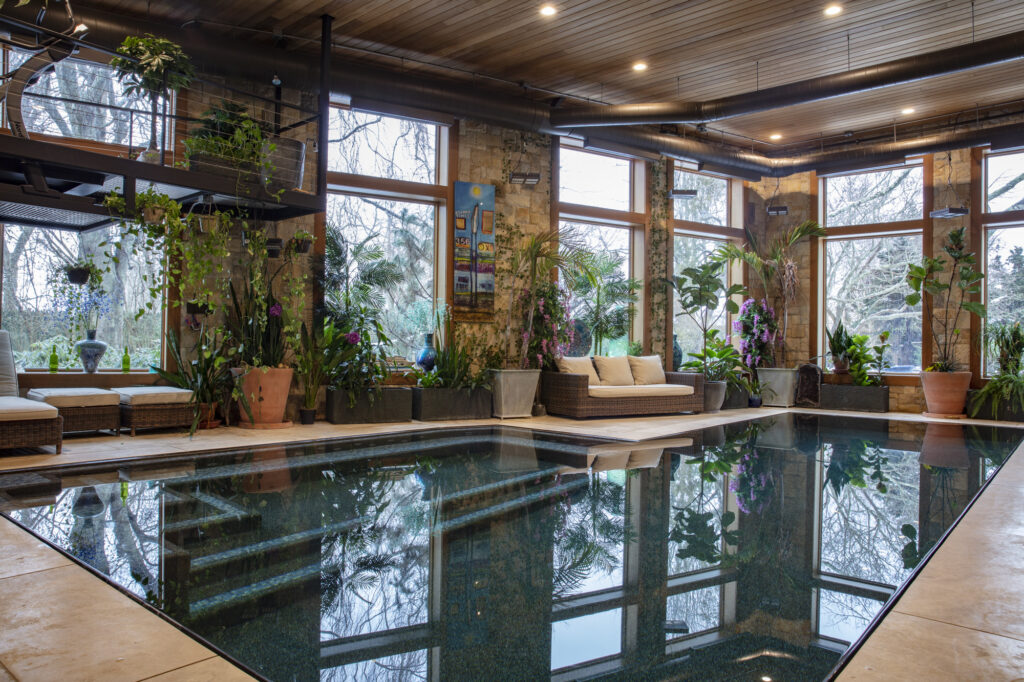
A NATURAL COMPANION
It can be tricky to explain how UV works. I’ve seen many descriptions, and this one from evoqua.com explains it as well as any I’ve found:
Ultraviolet (UV) light is energy within the electromagnetic spectrum that has shorter wavelengths than that which are visible to the human eye. UV light is a range of electromagnetic waves from 100 to 400 nanometers (between x-ray and visible light). The division of UV light is classified as Vacuum UV (100-200 nm), UV-C (200-280 nm), UV-B (280-315 nm) and UV-A (315-400 nm). The energy waves provided in the UV-C spectrum demonstrate the germicidal efficiencies that provide highly effective disinfection.
In our systems, we create a bypass loop that uses an ozone generator and a contact tank to treat 25% of the circulation. For that 25%, ozone does an amazing job of oxidizing organic compounds and killing microorganisms. The remaining 75 percent is sanitized using UV, which is installed downstream of the ozone bypass.
UV has the added benefit of destroying excess ozone before it re-enters the pool, which has major implications for indoor pools, especially where ozone off-gassing can be dangerous and is prohibited.
In other words, the two technologies complement each other. Neither would be nearly as effective without the other. UV is a perfect role player, which is why we use it!
WHY CHLORINE?
For more than 100 years, chlorine has been the primary chemical used to treat swimming pool water and public drinking water. It remains in widespread use in spite of the fact that it has stiff competition from so-called alternative sanitizers.
For all of its water-treatment supremacy and long-time use, chlorine remains badly misunderstood. To a large extent, it has been maligned, even demonized, and that’s really too bad. The reason for the negativity surrounding chlorine is, I believe, due to the way it’s been misused and over-used.
The ills associated with chlorine are familiar and have almost become a mantra for those who seek to eliminate it altogether. It’s harsh on skin, eyes, hair, and bathing suits; it smells; it’s highly corrosive; it forms disinfection byproducts; and it can be rendered almost useless at high pH and in pools with elevated cyanuric acid levels.
Truth be told, most of those issues – particularly the smell as well as skin and eye irritation – are the result of disinfection byproducts such as chloramines, which form when free available chlorine oxidizes compounds containing ammonia and nitrogen. The fact that it’s pH sensitive is only a problem in pools with improper water balance. Plus, its complex relationship with cyanuric acid, a UV (from sunlight) stabilizer, only becomes an issue if you let the cyanuric acid level climb too high.
Nonetheless, the dark side of chlorine has given rise to an ethos that says less is more and none is even better. Still, there are reasons that chlorine has stuck around in spite of the negative perception. It’s both an effective oxidizer and sanitizer, it stays in solution, and it can be stabilized in sunlight, which other sanitizers such as bromine and biguanides cannot. No other chemical I know combines all those upsides.
LAYER OF PROTECTION
The problems associated with chlorine occur when it’s used as a solo act. When used alone, the recommended 1-to-3 parts per million (ppm) in a residential pool and 3-to-5 ppm in a commercial pool can be problematic. First of all, even when you’re using a feeder and/or an oxidation reduction potential (ORP) controller, the level of free available chlorine, hypochlorous acid, will fluctuate due to chlorine demand courtesy of bathers and other environmental factors.
At those residual levels, there’s a lot of chlorine in the water that will combine with organic compounds and form the unwanted by-products and particularly trichloramine, which causes the chlorine smell.
That all points to a simple remedy — keep the residuals down. That’s one of the many reasons our preferred treatment method involves ozone, UV, and chlorine. In our systems, we maintain a small 0.6-ppm chlorine level to kill any bacteria that develops in the pool itself before the water has had a chance to circulate through the UV and ozone systems. In other words, the chlorine plays a limited role yet offers a very necessary measure of protection.
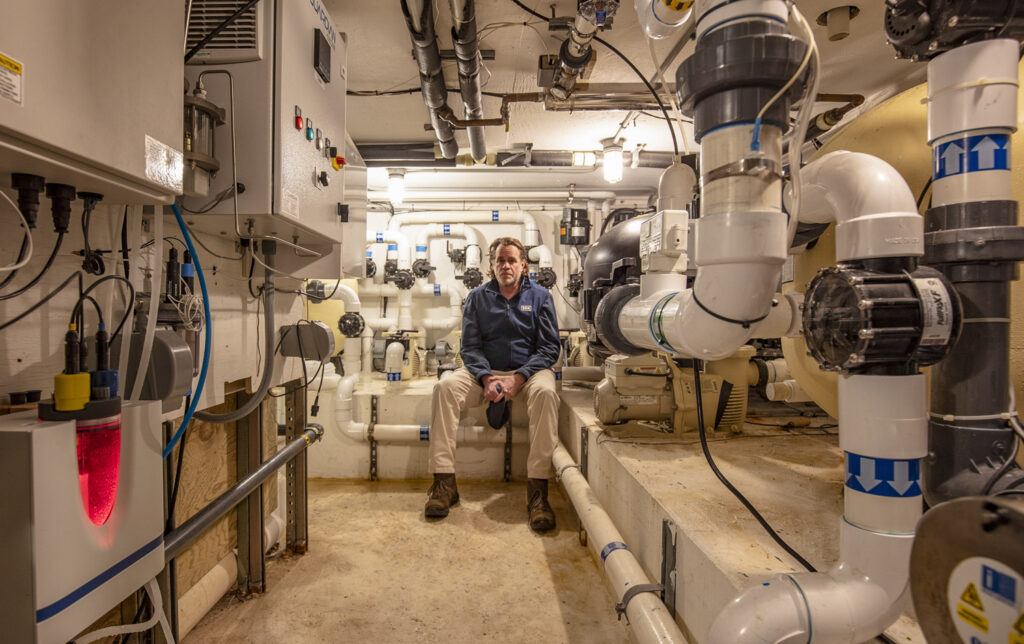
MANY FLAVORS
Prior to developing our system, I was like many, many other service technicians, driving around with a huge amount of liquid bleach in my truck, which is expensive and, to an extent, somewhat hazardous.
I was constantly testing and adding chlorine to keep up with the demand, which was almost impossible in high-use pools. When the combined chlorine, i.e., by-products, developed or the pool had an algae bloom, I’d turn to either chlorine or non-chlorine shock, which requires adding huge amounts of chemicals to reach what chemists call “breakpoint chlorination.”
Using chlorine as the one and only sanitizer was like living on the proverbial hamster wheel. It felt like a futile pain in the backside.
Chlorine is sold in many forms and over the years, I have tried them all. And all that experience taught me that each type of chlorine has different characteristics and using each correctly means selecting the right type for the application at hand. To sum up, you have to understand the specific characteristics of the chlorine you’re using. Some types dissolve very slowly and others more quickly. Some perform better in hot water than others.
Overall, I’ve found that when you use chlorine in a sparing way, the problems associated with it essentially vanish. Using less also saves money, which contributes to the return on investment for the other systems we use.
That’s why I believe the objective shouldn’t be to eliminate chlorine, but instead to use it in the best possible way.
Steve Kenny is founder of SRK Pool Services, a pool design/build and service company based in Wainscott, N.Y. He has more than 25 years’ experience studying and finetuning water chemistry in an effort to generate the best possible experience for his customers. He is passionate about and devoted to the science, methods and art of ensuring impeccable water-quality condition. He is a lifetime sailing enthusiast, published author and photographer.
the Water Geek
CATEGORIES

A blog about all things water, written by SRK's founder Steve Kenny.


